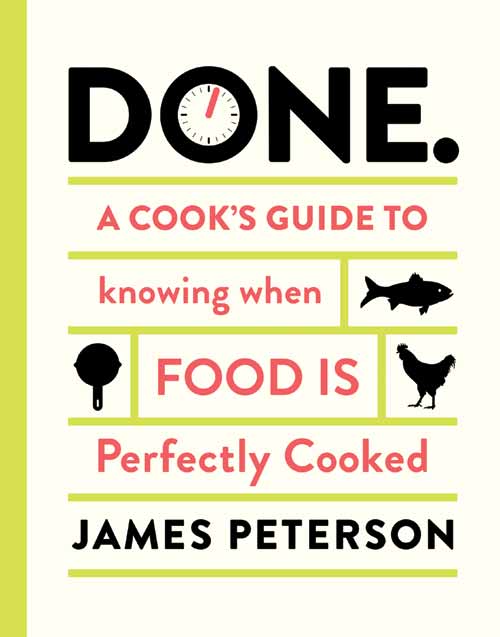Share This
QUICK — Think of a mistake that ruined a meal. I bet many (or most) of you came up with something that was over or undercooked. Well today we have your salvation in the kitchen. James Peterson’s latest book, Done: A Cooks Guide to Knowing When Food is Perfectly Cooked, tells readers exactly that, how to know – by sound, smell, look and feel – when something is done. How great is that?
The beauty of this book is that you can read it from cover to cover, taking away special nuggets of knowledge with each page, or you can search for a particular food you may need help determining doneness for and James is there to help. And today he is here to help our blog readers by answering some questions about his latest book.
OLDWAYS: Can you share a tale of something you overcooked and felt terrible about?
JAMES: About six months ago, I’m sitting at my desk and I get a call. A woman asks if this is James Peterson. When I say yes, she says: “You ruined my Thanksgiving dinner.” Oh no, I thought. What have I done? She talked me through what she had done and indeed she had followed all the directions to the letter. However, when she cut into the turkey, she saw pink. Well, the only other person I know who embraces my assertion that poultry should be pink inside (but by no means raw) is Wolfgang Puck. So at least I’m in good company. So I asked her if she at least ate the breast meat which was probably perfectly cooked. She said that she threw the whole thing in the trash. So while this lady behaved like an idiot, it was ultimately my responsibility. I should have warned her that it would be pink and give her the option to cook it more to make it all brown.
And for an overcooked instance of my own making, I was at my aunt Jane’s in Los Angeles. It was up to me to grill the steaks for dinner. Well, Jane thought she was a better cook than I so I always felt this competitive thing. The net result was that I ruined just about anything I undertook. So, those poor steaks, in keeping with my theme, ended up overdone and my reputation was ruined.
OLDWAYS: When did you realize Done had to be written?
JAMES: My editor came up with the idea but I rapidly concurred since that’s what everyone says who claims they can’t cook. Everyone says, “But I don’t know when it’s done.” Since doneness is the Achilles heel of many foods, it is essential to know how to determine it.
OLDWAYS: What foods do you think people most commonly overcook?
JAMES: People ruin fish, pork, and poultry. The fish is always flaky and dry and poultry and pork are always just dry.
OLDWAYS: Done is not a cookbook in the traditional sense, in fact you even call it a handbook. Why is it an essential to every home kitchen?
JAMES: Done works on giving the people the cues for determining doneness. While it’s impossible to impart how foods should feel or exactly look when they’re done, I at least tell people what they should be aware of: such things as blood formation, resistance to the touch, and internal temperature.
OLDWAYS: Glazing, braising, sautéing and more! There are so many methods and even more ingredients to apply to each. What are some common mistakes people make when approaching various methods of cooking?
JAMES: People glaze with too much liquid. (Most recipes say to fill the pan so it comes halfway up the sides of the vegetables; I say a third.) Again, people braise with too much liquid. It’s very important that the pan fit the size of the object being braised. Cooks need to understand that a braising liquid can be reduced. People sauté over too low a heat. Meat and fish must be cooked in a hot pan or they will release liquid that will accumulate in the pan and cause the food to steam.
OLDWAYS: For someone just starting out in this ‘mastery of doneness’ is there an order of methods you suggest they master?
JAMES: Feel is the most important, followed by blood or juice formation. For fowl, it’s best to look at the juices in the cavity and the feel of the breast meat.
OLDWAYS: If there is one golden nugget of information that you can leave with our readers what would that be?
JAMES: Don’t hesitate to take foods out of the oven or off the grill to check for doneness. There is nothing wrong with cutting into foods to see how they look. The important thing is to observe what the food looks and feels like from the outside as you check the appearance on the inside. Please don’t overcook poultry and pork. Even a soufflé can be taken out of the oven, scooped into, and if raw in the middle just slid back in the oven.



Add a Comment